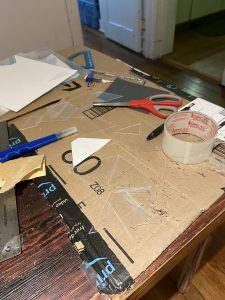This week, I spoke with our TA to approve purchases and subsequently submitted the order for several necessary purchases: a daughter card for our FPGA board and jumper wires to connect the Arduino and cameras with the FPGA board.
Furthermore, I checked the material needed by our eventual pyramid by visiting the physical location of Home Depot to check the acrylic sheets they had in stock, in order to verify sheet thinness and stiffness. The material needs to be thin, to avoid doubled reflections, and stiff, to avoid distortion. I ordered 11”x10”x0.50” clear, non-glare acrylic sheets and a plastic cutter to prototype the pyramid. After receiving the materials, I built a 1:5.85 scale pyramid prototype with the acrylic sheets and masking tape:


Figure 1 (on left): Acrylic trapezoids cut out with a plastic cutter, mid-assembly with masking tape
Figure 2 (on right):Demo of prototype over a pre-baked video.
From this holographic pyramid prototype, several issues have become immediately apparent:
- This is definitely not the material we will be using. It is not transparent enough and the resultant reflection is extremely blurry. This may be an issue with the non-glare nature of the acrylic, and this means that Home Depot does not stock the material that we will need, since they did not have other kinds of acrylic. We will need to find either clearer acrylic sheets or switch to glass.
- Cutting with a $5 plastic cutter is time-consuming, even with thin acrylic sheets and small shapes. It took me “practice” (otherwise known as several misshapen trapezoids) and a few hours. My cuts were also imprecise. For our final product, we may need to either purchase pre-cut material or take advantage of the laser cutter.
- Masking tape is also not the material to use to assemble a pyramid, as it is overly flexible and obscures parts of the holographic pyramid. Glue would work better.
- Our requirement for “office lighting” will be difficult to meet. The blurry holographic illusion only appeared in low lighting, and this means that our eventual pyramid will likely require something on top to artificially dim the pyramid to keep the reflection visible.
My progress is on schedule in that I have built a prototype for our eventual pyramid. My progress is not on schedule in that this pyramid fails to prove that we have picked the correct material or the correct stratagem for cutting and assembling the pyramid.
As my teammates plan to work with the cameras next week, I will switch from that task to instead find the correct material and strategy to make the pyramid, so that we will be on track with assembly of the physical hardware by the midpoint demo. I will do this while working on our design review report.